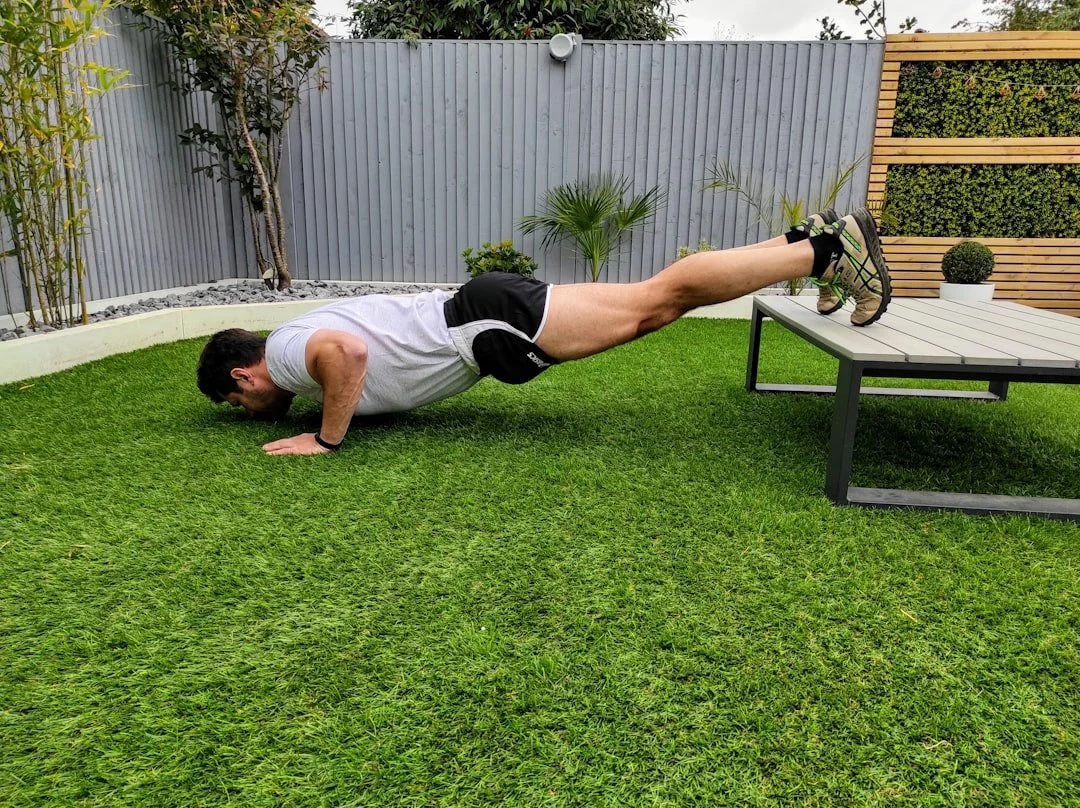Push-Up Progressions: From Park Bench to Full Rep
By Get Back Physical Therapy • 2025-10-16
Last week at Red Rocks, I watched a sunrise workout class hit the push-up portion. Half the group dropped straight to their knees, the other half managed maybe three reps before their backs started sagging. Pretty standard, actually—recent data shows 54% of Americans can't do 10 proper push-ups.
Denver's thin air doesn't help either. At 5,280 feet, everything feels about 20% harder, including push-ups. They've been around forever—ancient Greek warriors did them for combat training—yet most of us still struggle with them.
The Push-Up Paradox: Simple Yet Impossible
The push-up is deceptively complex. It requires you to move approximately 64% of your body weight while maintaining a rigid plank position. Your triceps fire at 73-109% of their maximum capacity, your chest muscles work at 95-105%, and your core has to stabilize everything in between.
Add Denver's altitude—your oxygen uptake drops about 12% up here—and that "simple" exercise gets a lot harder.
Most fitness advice treats push-ups like you either can or can't do them. That's wrong. Push-ups exist on a spectrum, and once you understand that spectrum, progression becomes straightforward.
Advanced variation: Declined push-ups increase load by approximately 75% of body weight
The Force Spectrum: Understanding Push-Up Physics
Push-ups work like a dial, not a switch. Change your body angle, and you control exactly how much weight you're pushing:
Wall Push-Ups (Standing): ~20% body weight
Incline Push-Ups (Bench Height): ~40% body weight
Knee Push-Ups: ~49% body weight
Standard Push-Ups: ~64% body weight
Declined Push-Ups (Feet Elevated): ~75% body weight
EMG research backs this up—muscle activation scales predictably with each progression. Your nervous system doesn't know or care that you're doing "modified" push-ups. It just responds to progressive overload.
Real Denver Success: From Zero to Twenty
"I couldn't do a single push-up when I started. At 45, after years at a desk job in LoDo, I thought that ship had sailed. Brett had me start with wall push-ups at home, then we progressed to the benches at Confluence Park during lunch breaks. Eight weeks later, I did my first real push-up. Now, six months in, I can knock out 20. The key was having permission to start where I was, not where I thought I should be." — Sarah, Highlands Ranch
The Denver Park Bench Progression System
You don't need expensive equipment. Every park bench in Washington Park, City Park, or Cheesman Park works perfectly for push-up progressions.
Level 1: The Wall Start (0-2 weeks)
Start with any wall or sturdy tree. Hands shoulder-width apart, step back to about a 45-degree angle. This is where 36% of Americans need to start. Nothing wrong with that—it's a foundation.
Target: 3 sets of 15-20 reps
Level 2: Park Bench Incline (2-6 weeks)
Those green benches along Cherry Creek Trail work great for the next step. Using the bench back drops the load to about 40% body weight while keeping proper form.
Target: 3 sets of 12-15 reps
Using elevation changes to control resistance—Denver's parks are your free gym
Level 3: Bench Seat Height (6-10 weeks)
Drop down to the bench seat (about 18 inches). You're now pushing roughly 50% body weight—the sweet spot where real strength develops.
Target: 3 sets of 10-12 reps
Level 4: Ground Zero (10-14 weeks)
Now for full push-ups. Quality matters more than quantity—one perfect push-up beats 10 sloppy ones with your back sagging.
Target: 3 sets of 5-8 perfect reps
Level 5: Advanced Variations (14+ weeks)
After you can do 15 clean push-ups, you've got options:
Diamond push-ups: Narrow hand position increases triceps activation by 20%
Wide-grip: Targets outer chest, changes force vectors
Tempo push-ups: 3 seconds down, 1 second pause, explode up
Single-leg elevated: Hello, core stability
The Altitude Adjustment Protocol
Your muscles work with less oxygen at elevation, but this accelerates certain adaptations. University of Colorado research shows altitude residents develop more efficient mitochondria, which fuel muscular endurance.
To optimize for Denver's elevation:
Rest longer between sets: Add 15-30 seconds to standard rest periods
Focus on breathing: Exhale on the push, inhale on the descent
Hydrate aggressively: Dehydration at altitude kills performance faster than at sea level
Common Push-Up Crimes and How to Fix Them
The Saggy Spine: Your lower back dips like Colfax Avenue. Fix: Imagine someone's about to punch you in the gut. That tension maintains spinal alignment.
The Chicken Neck: Head jutting forward like you're pecking for crumbs. Fix: Keep your gaze slightly ahead of your hands, not straight down.
The T-Rex Arms: Elbows flared 90 degrees from your body. Fix: 45-degree angle protects your shoulders and maintains proper force production.
When to Stop: Warning Signs You Shouldn't Ignore
Before starting any progression, know these red flags that mean you should pause and potentially seek professional help:
Sharp pain in wrists, elbows, or shoulders (different from muscle burn)
Numbness or tingling in hands or arms
Pain that persists more than 48 hours after exercise
Shoulder clicking or catching with movement
Lower back pain during or after push-ups
These aren't weakness. Your body's telling you to try a different approach.
Recovery: The Missing Piece
Most push-up programs fail because they ignore recovery. At altitude, this becomes even more critical:
Rest Days Matter: Allow 48 hours between push-up sessions. Your muscles rebuild stronger during rest, not during exercise.
Progress Monitoring:
Week-over-week, aim for 10-20% more total reps
If you can't match last week's performance, take an extra rest day
Regression is normal at altitude—don't force through it
Active Recovery: On off days, do shoulder rolls, arm circles, and gentle stretching. Walk the Cherry Creek Trail. Movement without load promotes healing.
The 6-Week Challenge: From Zero to Ten
This progression has worked for Denver clients going from zero to 10 consecutive push-ups:
Weeks 1-2: Wall push-ups, 4 sets of 15, 3x per week (M/W/F) Weeks 3-4: Bench incline, 4 sets of 12, 3x per week Week 5: Mix bench seat and knee push-ups, 5 sets of 8 Week 6: Full push-ups, as many sets as needed to total 30 reps
Track everything. Progress isn't linear, especially at altitude, but consistency wins.
Making It Work
Push-ups aren't about proving something to anyone. They're about building functional strength that translates to real life—whether that's pushing yourself up after a mountain bike crash on Buffalo Creek Trail or playing with your kids at Stapleton's Central Park.
There's always a push-up variation that matches your current level. Those park benches become training tools, taking you from where you are to where you want to be.
Every elite athlete started with rep one. Denver's thin air makes that first rep harder, sure, but it also builds more strength. Think of altitude as built-in resistance training.
Ready to master push-ups and build real functional strength? Get Back Physical Therapy specializes in progressive strength training tailored to Denver's unique environment. Our movement specialists can assess your current level and create a personalized progression plan that works with your body, not against it.
Start your strength journey today →
References
Gymless.org. (2021). Nationwide Survey: Majority of Americans Cannot Do More Than 10 Consecutive Pushups. Survey of 2,000 Americans aged 18+.
Cogley, R.M., et al. (2005). Comparison of muscle activation using various hand positions during the push-up exercise. Journal of Strength and Conditioning Research, 19(3), 628-633.
Ebben, W.P., et al. (2011). Kinetic analysis of several variations of push-ups. Journal of Strength and Conditioning Research, 25(10), 2891-2894.
University of Colorado Boulder. (2023). Altitude Training and Mitochondrial Adaptations in Athletes. Department of Integrative Physiology.
JAMA Network Open. (2019). Association Between Push-up Exercise Capacity and Future Cardiovascular Events Among Active Adult Men. February 15, 2019.


